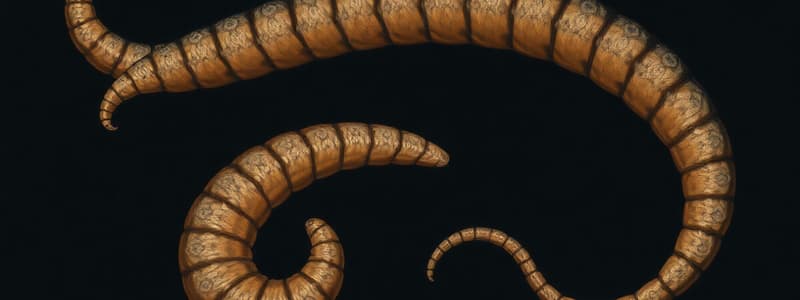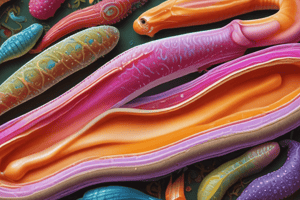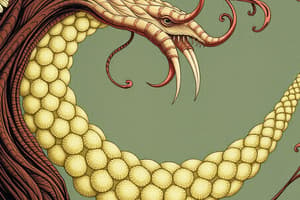Podcast
Questions and Answers
Cestodes, also known as ______ or tapeworms, are multicellular worms with a flat, ribbon-like appearance.
Cestodes, also known as ______ or tapeworms, are multicellular worms with a flat, ribbon-like appearance.
flatworms
The typical life cycle of cestodes begins with an ______ containing a hexacanth embryo.
The typical life cycle of cestodes begins with an ______ containing a hexacanth embryo.
egg
Cestodes absorb nutrients and excrete waste products through their outer surface known as the ______.
Cestodes absorb nutrients and excrete waste products through their outer surface known as the ______.
tegument
The ______ (anterior end) of a cestode typically contains four cup-shaped structures known as suckers or acetabula.
The ______ (anterior end) of a cestode typically contains four cup-shaped structures known as suckers or acetabula.
The series of proglottids that make up the body of a cestode is called the ______.
The series of proglottids that make up the body of a cestode is called the ______.
Mature proglottids are ______, containing both male and female reproductive organs.
Mature proglottids are ______, containing both male and female reproductive organs.
[Blank] proglottids are filled with a uterus full of eggs, which rupture to release the eggs into the intestine.
[Blank] proglottids are filled with a uterus full of eggs, which rupture to release the eggs into the intestine.
Infections with E. granulosus can lead to liver and lung involvement, and a serious allergic reaction known as ______.
Infections with E. granulosus can lead to liver and lung involvement, and a serious allergic reaction known as ______.
Taenia spp. are platyhelminths and members of the class ______.
Taenia spp. are platyhelminths and members of the class ______.
The common name for Taenia solium and Taenia saginata is ______ tapeworm.
The common name for Taenia solium and Taenia saginata is ______ tapeworm.
The anterior part of the tapeworm responsible for attachment to the intestinal wall is the ______.
The anterior part of the tapeworm responsible for attachment to the intestinal wall is the ______.
Taenia solium's scolex is spherical and contains a fleshy ______.
Taenia solium's scolex is spherical and contains a fleshy ______.
Taenia saginata proglottids are typically ______ and have 15 to 30 uterine branches on each side of the uterus.
Taenia saginata proglottids are typically ______ and have 15 to 30 uterine branches on each side of the uterus.
The vagina of T. saginata has a ______.
The vagina of T. saginata has a ______.
Ingestion of T. solium ______ leading to larval development (cysticerci) in various tissues including the brain is known as cysticercosis.
Ingestion of T. solium ______ leading to larval development (cysticerci) in various tissues including the brain is known as cysticercosis.
Taenia saginata is typically diagnosed by the passage of ______ or segments in the stool.
Taenia saginata is typically diagnosed by the passage of ______ or segments in the stool.
For laboratory diagnosis of Taenia saginata, the first specimens usually brought in by patients are the ______.
For laboratory diagnosis of Taenia saginata, the first specimens usually brought in by patients are the ______.
Taenia saginata infection is treated with ______
Taenia saginata infection is treated with ______
Hymenolepis diminuta is commonly called ______.
Hymenolepis diminuta is commonly called ______.
Hymenolepis diminuta eggs contain a hexacanth embryo with ______.
Hymenolepis diminuta eggs contain a hexacanth embryo with ______.
Hymenolepis diminuta proglottids are typically ______.
Hymenolepis diminuta proglottids are typically ______.
Hymenolepis nana infections are caused by a species commonly known as ______.
Hymenolepis nana infections are caused by a species commonly known as ______.
Only human tapeworms that can complete their life cycle in a [blank.
Only human tapeworms that can complete their life cycle in a [blank.
Dipylidium caninum is commonly known as the ______.
Dipylidium caninum is commonly known as the ______.
Eggs are usually captured in ______ inside Dipylidium caninum infections.
Eggs are usually captured in ______ inside Dipylidium caninum infections.
Flashcards
Cestodes Characteristics
Cestodes Characteristics
Multicellular worms with a flat or ribbon-like appearance.
Scolex/Head
Scolex/Head
The anterior end of a cestode, used for attachment. Contains suckers/acetabula.
Strobila/Body
Strobila/Body
Series of segments that comprise the body of a cestode.
Proglottids
Proglottids
Signup and view all the flashcards
Hermaphroditic
Hermaphroditic
Signup and view all the flashcards
Gravid Proglottids
Gravid Proglottids
Signup and view all the flashcards
Apolysis
Apolysis
Signup and view all the flashcards
Cysticercus/Cysticerci
Cysticercus/Cysticerci
Signup and view all the flashcards
Oncosphere
Oncosphere
Signup and view all the flashcards
Proglottid
Proglottid
Signup and view all the flashcards
Proglottids or segments
Proglottids or segments
Signup and view all the flashcards
Praziquantel
Praziquantel
Signup and view all the flashcards
H. diminuta eggs
H. diminuta eggs
Signup and view all the flashcards
Accidental parasitic disease
Accidental parasitic disease
Signup and view all the flashcards
Hymenolepis nana
Hymenolepis nana
Signup and view all the flashcards
Clinical Manifestations
Clinical Manifestations
Signup and view all the flashcards
Gravid Proglottids
Gravid Proglottids
Signup and view all the flashcards
Eggs
Eggs
Signup and view all the flashcards
Human transmission
Human transmission
Signup and view all the flashcards
Terminal Four-Fifths of the worm
Terminal Four-Fifths of the worm
Signup and view all the flashcards
B12 Deficiency
B12 Deficiency
Signup and view all the flashcards
Hydatid cyst
Hydatid cyst
Signup and view all the flashcards
Hydatid
Hydatid
Signup and view all the flashcards
Adult Worm
Adult Worm
Signup and view all the flashcards
Hydatid Cyst
Hydatid Cyst
Signup and view all the flashcards
Study Notes
- Lecture covers Cestodes, also known as Flatworms or Tapeworms, are multicellular worms with a flat or ribbon-like appearance
General Characteristics
- Cestodes' eggs are generally not motile, but cestode eggs themselves are motile and able to move around
- The first larval stage has six small hooks, called hooklets, arranged in pairs, which pierce the intestinal wall of the infected host
- Larval forms aren't seen in human specimens
- The tegument absorbs nutrients and excretes waste through the outer surface
- Adult parasites in this group have reproductive systems but lack a digestive tract
Common Features of Adult Cestodes
- The scolex/head (anterior end) has four cup-shaped structures called suckers/Acetabula
- These suckers facilitate attachment to the intestinal mucosa of the infected host
- Some species have a fleshy extension called a Rostellum, that may contain one or two rows of hooks
- The neck region connects the scolex to the rest of the worm
- The strobila/body is a series of proglottids
- Proglottids are individual segments equipped with both male and female reproductive organs
Internal Structures
- Cestodes are hermaphroditic; both male and female reproductive organs are present in the mature proglottid, allowing self-fertilization
- Following self-fertilization, pregnant (gravid) proglottids consist of a uterus filled with eggs
- Gravid proglottids rupture and release eggs into the intestine
- Eggs are usually passed into the outside environment via the stool
Clinical Parasitology: Pathology and Symptoms
- Immature proglottids are small lacking reproductive organs (closest to scolex)
- Mature proglottids develop both male and female reproductive organs
- Gravid proglottids are filled with eggs
- Liver and lung involvement are common in people infected with E. granulosus
- Affected patients may develop a persistent cough, localized pain, and eosinophilia
- Anaphylactic shock, which produces large histamine amounts and other chemical mediators, may develop under appropriate conditions and can be fatal
- Often asymptomatic
- Symptomatic cases present with gastrointestinal discomfort, diarrhea, and abdominal pain
- Can also cause intestinal obstruction and vitamin B12-induced macrocytic anemia, especially with Diphyllobothrium latum
General Laboratory Diagnosis
- Stool exams can detect eggs, gravid proglottids (occasionally), and scolices (rarely, after treatment)
- Tissue biopsy is used for E. granulosus
- Serologic tests
Taenia Species
- Taenia solium is Pork Tapeworm, Taenia saginata is Beef Tapeworm, and Taenia asiatica is Asian tapeworm
- Infection is highly related to eating raw and improperly cooked meat
Taenia spp. eggs
- Somewhat roundish
- Contain a hexacanth embryo with the standard three pairs of hooklets
- Some tapeworm eggs have a yellow-brown shell called an embryophore with distinct radial striations
Taenia spp. proglottids
- T. solium’s are square in appearance
- Have 7 to 15 uterine branches on each side of the uterus (7 to 13 lateral branches)
- T. saginata’s are typically rectangular
- Have 15 to 30 uterine branches on each side (15 to 20 lateral branches)
Taenia Terms
- Proglottid: segment or body part of a tapeworm
- Gravid proglottid: segment filled with eggs
- Oncosphere: embryonated egg or hexacanth embryo
- Scolex: anterior part of the tapeworm responsible for intestinal wall attachment
- Cysticercus/Cysticerci: larval stage where oncospheres develop and migrate to form cysticerci in tissues
Key Facts for Taenia solium
- Pork Tapeworm
- Disease: Taeniasis or Cysticercosis
- Eggs are indistinguishable from T. saginata
- Is distinguished via its scolex
Key Facts for Taenia saginata
- Beef Tapeworm
- Disease: Taeniasis
More Taenia Facts
- T. saginata’s vagina has a sphincter
- Gravid proglottids of T. saginata are most distal from the neck
- Gravid proglottids undergo apolysis and are either passed out with feces or actively crawl out of the bowel
- Invaginated: in muscle tissue
- Evaginated: scolex attached to mucosa of the small intestine
Taenia Treatment notes
- T. solium: Both Cysticercosis & Taeniasis are present
- Taeniasis caused by ingestion of cysticerci from undercooked pork with Cysticercosis caused by ingestion of T. solium eggs, leading to larval development in various human tissues, including the brain (NCC)
- Cyticercus cellulosae is found in pigs & man
- T. saginata: Only Taeniasis is present, no Cysticercosis
- Taeniasis is caused by ingestion of cysticerci from undercooked beef with Cysticercus bovis found in cattle
- Measly pork - Improperly cooked meat/ infected meat
Clinical Manifestations of Taenia
- Taenia solium
- TAENIASIS (intestinal infection): Mild, non-specific abdominal complaints
- CYSTICERCOSIS (tissue involvement): Cysticerci develops in any organ or tissue, develops in the brain causing NCC (Neurocysticercosis)
- Convulsion, Visual & motor deficits, Vomiting, and Headache
- Taenia saginata
- Most common chief complaint is the passage of proglottids or segments in the stool
- Mild irritation at the site of attachment.
- TAENIASIS (non specific symptoms)
- Epigastric pain, Vague discomfort, Hunger pangs, Weakness, Weight loss, Loss of appetite, Pruritus ani (perianal itching)
- Entangled proglottids result into intestinal obstruction (Rarely)
- Obstruction in the bile and pancreatic ducts, as well as appendix (due to actively motile proglottids)
Laboratory Diagnosis of Taenia
- Stool examination will show identification of eggs & proglottids
- Eggs: Indistinguishable with T. saginata
- Gravid proglottids:
- T. solium has 7 to 15 lateral branches
- T. saginata has 15-20 lateral branches
- Other tests: Serum to test for ELISA (Enzyme-Linked Immunosorbent Assay), EITB (Enzyme-Linked Immunoelectrotransfer Blot), or Western blot (IgG; IgM)
- First specimens usually brought in by patients are the gravid proglottids, either single or in chains
- Gravid proglottids are pressed or flattened in between two glass slides and are examined against the light (Used for a rough count of the lateral branches from the main uterus. or for injection of India ink through the genital pore for an accurate count)
- Examination of eggs are performed with: FEACT, DFS
- Perianal swabs will show eggs left in perianal skin as the gravid segments squeeze out of the anal opening
Taenia Treatment
- The drug of choice for T. saginata is praziquantel
- The drugs of choice for T. solium - Taeniasis are praziquantel and niclosamide (Delay is not recommended because of the theoretical possibility of autoinfection and subsequent cysticercosis)
- Praziquantel works against is affective against the entire adult form (Though isn’t used where there is ocular or CNS involvement)
- Paramomycin & quinacrine hydrochloride (Atabrine) may also be used as alternative
- For managing Taenia NCC, Albendazole is administered at 400 mg twice daily for 8 to 30 days where Praziquantel at a dose of 50 to 75 mg/kg divided into three doses is used for 30 days
- Corticosteroids or Subarachnoid form require surgical removal
- Praziquantel paralyzes the tapeworm, resulting in removal from the intestine, where Albendazole disrupts metabolism of the parasite, leading to its death
- Niclosamide inhibits glucose uptake of the tapeworm
- in T. saginata in PH, with surveys showing pigs affected more
Hymenolepis diminuta
- Common name: Rat tapeworm
- Disease: Hymenolepiasis, rat tapeworm disease
- Requries intermediate host
Hymenolepis diminuta: eggs
- Hexacanth embryo containing three pairs of hooks
- Hooklets shaped in a fan-like arrangement
- Presence of Bipolar thickenings but lacks the bipolar filaments
- A shell surrounds the embryo exhibits distinct polar thickenings but with no polar filaments
- Undergoes Bile stained embryophore
Hymenolepis diminuta: scolex and proglottids
- The scolex: Equipped with four suckers and has a smaller unarmed (No hooks) rostellum that protrudes from anterior
- The proglottids: Typically rectangular (twice as wide as long) where each mature proglottid will have 1 set of each reproductive organ
- Contains three ovoid testes and one ovary in a more or less straight pattern across segment
- A saclike Gravid Proglottid filled with eggs that occupy most of space
- Contains/undergoes Unilateral genital pores
Hymenolepis diminuta: Life Cycle
- Eggs, when ingested by wide range of insects (fleas, beetles, cockroaches, mealworms, and earwigs) develop into infective cysts
- When infected insects are ingested by humans or rat; they develop into the adult form
Hymenolepis diminuta: Treatment of disease
- Humans are accidental host for this infection
- Treat with by ingesting Praziquantel at 25mg/ kg for single dose
- Use Niclosamide to treat (effective alternative form)
- Transmuted through infected fleas that come into contact with food or drinks
Hymenolepis diminuta: Diagnostic Process
- Will experience zoonotic infections or zoonoses
- Use a Stool Exams to diagnosis
- To Identify: Eggs, Scolex (in rare conditions)
- Identifiable by non-circular shapes, larger sizes, Lack of filaments, or a present scolex
- Clinical manifestations:
- Will cause minimal and no specific detections (but life span is short - not severe in humans)
- Diarrhea, Nausea, Stomach pain, Lack of hunger
Hymenolepis nana
- Common name: Dwarf tapeworm
- Disease: Hymenolepiasis, dwarf tapeworm disease
- The smallest species of Tapeworms to infect
- Complete life cycle in single host
- Capable of harboring larvae AND completing life cycle
- spherical or subspherical
- Conspicuous poles where thick membrane meets
- 4-8 hair like structures are implanted in inner membrane
- Filaments are attached in inner memmrabne
- Has 3 pairs of hooks, where there is complete protection
Keynote details
- Some eggs will die immediately after released
- Centralized hook
- Contains/produces colourless embrophore
Proglottids details
- equipped with 4 suckers with sub globular shape
- Short hooks attached
Taenia Treatment notes
- Require Praziquantel - paralysis tapeworm leads to removal from intestine
- Albendazole - disrupts the parasites and inhibits spread
- Transmission can happen via hand to mouth spread
Transmission stages include these conditions
- Infected insect is ingested by mammals
- Infected by contamination of food
diphyllo-bothrium Latum
- Broad tape form and infection
Diagnostic notes
- Progolotidds don’t disintegrate and get released
- Capsules extremely hard to pick up
Eggs Features
- Thick shell with some operculum
- knob-like thickienknig
Scolex FEATURES
- Contains both bothria (sucking)
- Almond shape
Treatment
- Can give praziquantel
- Should not take B12
Clinicals notes include
- Not severe or extreme short diseases
- Causes diaherra, nauseous symptoms, stomach pains
Echinococcu granulosa
- tape form - dog
- Larave cycts in humans form in tissue
Adult stages of E - granulosus
- short neck with 3 - 4 segments
egg features
- islar ave stage
- contains brood capsules and outer wall segments
Adult is usually
- scolices 4 sucker
Studying That Suits You
Use AI to generate personalized quizzes and flashcards to suit your learning preferences.




